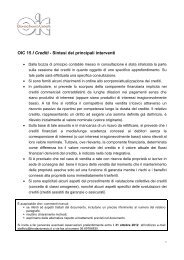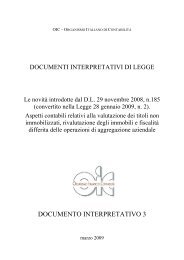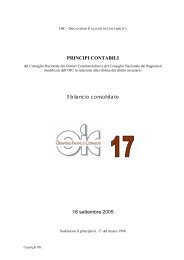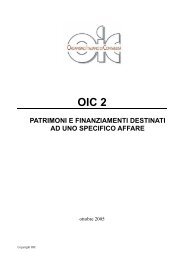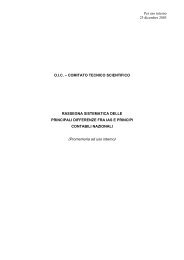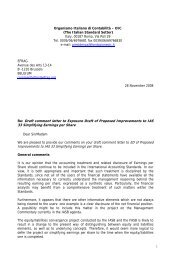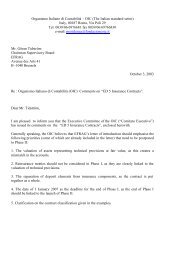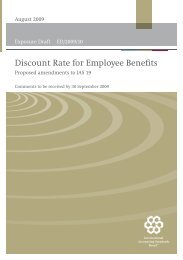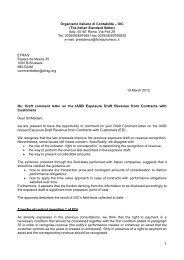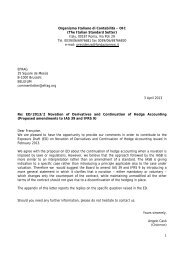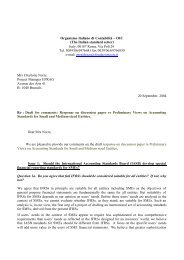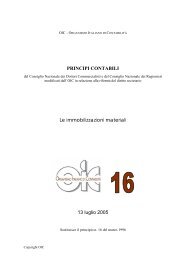OIC comments on EFRAG Draft comment letter on IASB ED of ...
OIC comments on EFRAG Draft comment letter on IASB ED of ...
OIC comments on EFRAG Draft comment letter on IASB ED of ...
Create successful ePaper yourself
Turn your PDF publications into a flip-book with our unique Google optimized e-Paper software.
Questi<strong>on</strong> 1 - Initial recogniti<strong>on</strong> <strong>of</strong> actuarial gains and lossesIAS 19 requires actuarial gains and losses to be recognised in pr<strong>of</strong>it or loss, either in the period inwhich they occur or <strong>on</strong> a deferred basis. The Exposure <strong>Draft</strong> proposes that entities should also beallowed to recognise actuarial gains and losses as they occur, outside pr<strong>of</strong>it or loss, in a statement<strong>of</strong> recognized income and expense.Do you agree with the additi<strong>on</strong> <strong>of</strong> this opti<strong>on</strong>? If not, why not?<str<strong>on</strong>g>OIC</str<strong>on</strong>g> Resp<strong>on</strong>seWe totally agree with the answer.We also c<strong>on</strong>sider that the provisi<strong>on</strong> under the current IAS 19 to determine an amortisati<strong>on</strong> periodwithin the residual average life <strong>of</strong> beneficiary workers does not mean a lack <strong>of</strong> transparency in thebalance sheet but rather it increases the transparency <strong>on</strong> the respect <strong>of</strong> the compliance with thefuture commitments towards those workers.Questi<strong>on</strong> 2 - Initial recogniti<strong>on</strong> <strong>of</strong> the effect <strong>of</strong> the limit <strong>on</strong> the amount <strong>of</strong> a surplus that canbe recognised as an assetParagraph 58(b) <strong>of</strong> IAS 19 limits the amount <strong>of</strong> a surplus that can be recognized as an asset to thepresent value <strong>of</strong> any ec<strong>on</strong>omic benefits available to an entity in the form <strong>of</strong> refunds from the planor reducti<strong>on</strong>s in future c<strong>on</strong>tributi<strong>on</strong>s to the plan (the asset ceiling).* The Exposure <strong>Draft</strong> proposesthat entities that choose to recognise actuarial gains and losses as they occur, outside pr<strong>of</strong>it orloss in a statement <strong>of</strong> recognised income and expense, should also recognise the effect <strong>of</strong> theasset ceiling outside pr<strong>of</strong>it or loss in the same way, i.e. in a statement <strong>of</strong> recognised income andexpense.Do you agree with the proposal? If not, why not?<str<strong>on</strong>g>OIC</str<strong>on</strong>g> Resp<strong>on</strong>seWe agree with <strong>EFRAG</strong>’s answersQuesti<strong>on</strong> 3 - Subsequent recogniti<strong>on</strong> <strong>of</strong> actuarial gains and lossesThe Exposure <strong>Draft</strong> proposes that, when actuarial gains and losses are recognised outside pr<strong>of</strong>itor loss in a statement <strong>of</strong> recognised income and expense, they should not be recognised in pr<strong>of</strong>itor loss in a later period (i.e. they should not be recycled).Do you agree with this proposal? If not, why not?
<str<strong>on</strong>g>OIC</str<strong>on</strong>g> Resp<strong>on</strong>seWe agree with <strong>EFRAG</strong>’s answersQuesti<strong>on</strong> 4 - Recogniti<strong>on</strong> within retained earningsThe Exposure <strong>Draft</strong> also proposes that, when actuarial gains and losses are recognised outsidepr<strong>of</strong>it or loss in a statement <strong>of</strong> recognised income and expense, they should be recognisedimmediately in retained earnings, rather than recognised in a separate comp<strong>on</strong>ent <strong>of</strong> equity andtransferred to retained earnings in a later period.Do you agree with this proposal? If not, why not?<str<strong>on</strong>g>OIC</str<strong>on</strong>g> Resp<strong>on</strong>seWe agree with <strong>EFRAG</strong>’s answersQuesti<strong>on</strong> 5 - Treatment <strong>of</strong> defined benefit plans for a group in the separate or individualfinancial statements <strong>of</strong> the entities in the group(a) The Exposure <strong>Draft</strong> proposes an extensi<strong>on</strong> <strong>of</strong> the provisi<strong>on</strong>s in IAS 19 relating to multiemployerplans for use in the separate or individual financial statements <strong>of</strong> entities within ac<strong>on</strong>solidated group that meet specified criteria.Do you agree with this proposal? If not, why not?(b) The Exposure <strong>Draft</strong> sets out the criteria to be used to determine which entities within ac<strong>on</strong>solidated group are entitled to use those provisi<strong>on</strong>s.Do you agree with the criteria? If not, why not?<str<strong>on</strong>g>OIC</str<strong>on</strong>g> Resp<strong>on</strong>seWe agree with <strong>EFRAG</strong>’s answersQuesti<strong>on</strong> 6 - DisclosuresThe Exposure <strong>Draft</strong> proposes additi<strong>on</strong>al disclosures that(a) provide informati<strong>on</strong> about trends in the assets and liabilities in the defined benefit plan andthe assumpti<strong>on</strong>s underlying the comp<strong>on</strong>ents <strong>of</strong> the defined benefit cost and(b) bring the disclosures in IAS 19 closer to those required by the US standard SFAS 132Employers’ Disclosures about Pensi<strong>on</strong>s and Other Postretirement Benefits.Do you agree with the additi<strong>on</strong>al disclosures? If not, why not?



